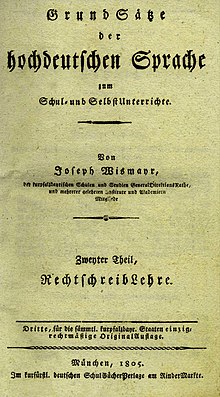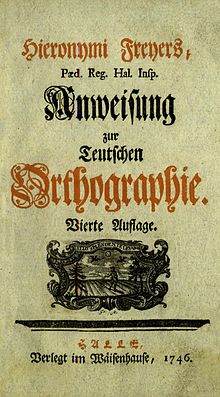Textbook of orthography
A textbook of orthography (also orthographic textbook , textbook of spelling or spelling theory ) teaches the writing rules of a language in an educational and systematic way.
Demarcation
Orthography textbooks are to be distinguished from writing textbooks, reading books, orthographic dictionaries and spelling rule books .
Writing and reading per se is taught in writing textbooks and reading books according to the applicable rules. In orthographic dictionaries, all words are listed alphabetically in the correct spelling. The orthographic rules are systematically presented in rule books for spelling.
A textbook on orthography, on the other hand, would like to put the reader in a pedagogical and systematic way in a position without using a dictionary himself to know or to be able to deduce the valid spelling of all words.
There are numerous forms of combination between these works, and in addition, in the times when the writing rules were generally changed or standardized, there were works that only made familiar with the respective changes. This was the case around 1880, 1901 and 1996, and was done both pedagogically and systematically using comparative lists.
history
Before the first orthography textbooks appeared, spelling gauges were usually part of or an appendix to letter writers .
- In 1722 Hieronymus Freyer's instructions on German orthography appear . The first part deals with the rules of orthography in a pedagogical structure. In the second part the rules are applied.
- In 1722 Heinrich Volck von Wertheims Gantz appears new and clear. Instructions for writing art, which consists of CALLIGRAPHIA or calligraphy art, ORTHOGRAPHIA or spelling art, TACHYGRAPHIA or speed writing art, STYLOGRAPHIA or connecting writing art, which four pieces actually make up the whole volume of writing art after his lessons and Use exists.
- In 1725 Thomas Hoffmann's instruction on orthography appears, insofar as it comes down to an exact differentiation of the identical words, According to alphabetical order, In useful and funny examples, [...] For the use of the youth in the trivial schools, those under the citation of one skilful teacher to a correct way of writing is thereby led, as it were, playfully, the same for everyone who wants to write a little more correctly.
- In 1725, Johann Burkhard Menkes published the latest instruction in the art of spelling .
- In 1745, Johann Gottlieb Vorsatz ' Instructions on German Spelling was published, based on the critical-historical contributions of the German Society in Leipzig.
- In 1750 an instruction on orthography appears under the pseudonym Theophilus .
- In 1788, Johann Christoph Adelung's Complete Instructions on German Orthography was published.
- Appears in 1796 Joseph Wismayrs Spell teaching than the second part of the principles of the High German language.
- 1803 was published by Johann Christian August Heyses auxiliary book for learning and promoting correct German pronunciation and spelling; can also be used as material for regulations, useful mind and style exercises. For home and public teaching.
- In 1807 Johann Christoph Friedrich Baumgarten's orthographic sheets and exercises were published. A resource to facilitate and promote the teaching of spelling.
- In 1820, Joseph Amler's Practical Guide appears to teach young people the most general rules of German orthography in a very easy way, in conversations and with many sentences chosen according to each rule, for practice in dictando writing, for teachers at trivial schools.
- In 1832, Raimund Jakob Wurst's Sprachdenklehre for elementary schools was published with an appendix, Von der Schriftsprache , a small spelling theory.
- In 1857 Karl Klaunig's rules and vocabulary for German spelling were published for use by the pupils of the general and urban secondary school in Leipzig. This textbook is not structured pedagogically, but systematically.
- From 1861, official spelling rules appeared in the German states , with which one can learn to spell, but which are not educational and cannot be viewed as textbooks in the narrower sense.
- In 1879 Friedrich Hoffmann's Common German Spelling was published.
- In 1895 Günther Saalfeld's Catechism of Spelling was published.
- In 1910 a standard work appeared: Joseph Lammertz ' Complete Spelling Theory. The work appeared in 19 editions until 1962.
- In 1935 Waldemar Straubes' The Spelling School appeared and by the end of the 20th century over 100 editions were printed.
Orthography textbooks (selection)

- Johann Christoph Adelung: Complete instructions on German orthography. Leipzig 1788.
- Joseph Amler: Practical instruction to teach young people the most general rules of German orthography in a very easy way. Graz 1807.
- Johann Christoph Friedrich Baumgarten : Orthographic sheets and exercise pieces. Leipzig 1807; 10th, revised edition 1847.
- Alfred Blaschko-Cziszewski: German sometimes like that - sometimes like that. Write correctly. A spelling theory worth reading and noticing in 12 letters for everyone. Berlin 1946.
- Max Essner: Writing correctly - German spelling book with dictionary. Berlin 1956.
- Hieronymus Freyer: Instructions for the German orthography. Hall 1722.
- Karl A. Gutmann, GN Marschall: Outline of the German language and spelling theory. Munich 1875.
- Johann Christian August Heyse: Help book for learning and promoting correct German pronunciation and spelling. Hanover 1803.
- Friedrich Hoffmann: The common German spelling. Peterwalden 1879.
- Thomas Hoffmann: Instructions for orthography. Leipzig 1725.
- Karl Klaunig: Rules and vocabulary for German spelling for the use of the pupils of the general citizen and municipal secondary school in Leipzig. Leipzig 1857.
- Ernst Kuhl: German spelling theory. Gotha 1878.
- Al. Knöppel: language and spelling theory. Munster 1891.
- Joseph Lammertz: Complete spelling theory. Paderborn 1905.
- Otto Lange: German spelling theory with a dictionary. Berlin 1866.
- Heinrich Leineweber: Student book - an aid for teaching German sentence, word and spelling theory. Trier 1889.
- Karl Martens: Spelling Book - methodical text and exercise book for teaching German spelling. Brunswick 1888.
- Johann Burkhard Menke: Short-term, very recent instruction in the art of spelling. Frankfurt and Leipzig 1725.
- Paul Pelshenke: Spelling is pleasure - the other spelling book. Darmstadt 1989.
- Günther Saalfeld: Catechism of the orthography. Leipzig 1895.
- Waldemar Straube: The spelling school. Wiesbaden 1935.
- Theophilus (pseudonym): Clear instruction in German orthography. Frankfurt and Leipzig 1762.
- Heinrich Volck von Wertheim: Gantz new and clear. Instruction for writing art. Chemnitz 1722.
- Johann Gottlieb intent: Instructions on German spelling. Hildburghausen and Meiningen 1745.
- Joseph Wismayr: Principles of the high German language. Second part of spelling theory. Munich 1796.
- Raimund Jakob Wurst: Sprachdenklehre for elementary schools with an appendix of the written language [§ 103 - § 115 spelling (orthography)]. Reutlingen 1837.
See also
literature
- Burckhard Garbe (ed.): The German orthography and its reform 1722–1974. Niemeyer, Tübingen 1978, ISBN 3-484-10294-2 (collection of essays and book excerpts on the history of German spelling).
- Günther Thomé: German orthography: historical - systematic - didactic. Basics of spelling. 2nd, improved edition. isb-Fachverlag, Oldenburg 2019, ISBN 978-3-942122-24-5 .

